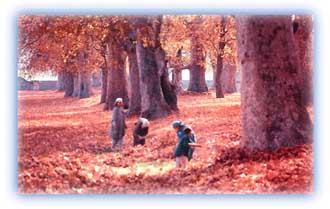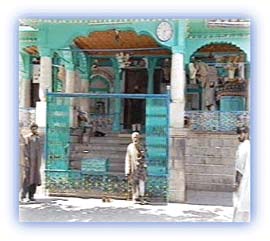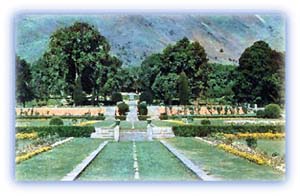Kashmir himalayas
General Info
· Lakes and Waterways
· Dal and Nagin lakes
· Mughal Gardens
· Shankaracharya Hill
· Liddar Valley
· Pahalgam and Amarnath
· Photos of Amarnath trek
· Famous meadows
· Gulmarg
· Sonmarg
Arts and Crafts
· Carpets and Shawls
· Miniature Paintings
People
· Legends

![]()
| History The earliest history of Kashmir was recorded by the poet- chronicler Kalhana in the 12th century. In his "Rajatarangini" (River of Kings), he traces the rise and fall of dynasties and the changing fortunes of kings and faiths. |
 |
| Autumn in Kashmir Credit: KOA |
After about five centuries, the faith suffered at the hands of Mihirigula, the White Hun, a man who was said to seldom smile and whose approach was signaled by 'vultures, crows and other birds which were flying ahead eager to feed on those who were to be slain'. Mihirigula's bloodthirsty depredations were luckily shortlived.
Less than a century later, around AD 600, the Karkota Dynasty was established which produced one of the most remarkable rulers in Kashmir's history, Lalitaditya. Lalitaditya ruled in the 8th century. Conquest extended his territories, but he was also a wise monarch who practised religious tolerance and brought prosperity to his people. Towns, temples, roads and canals were built. To him is ascribed the glorious Sun Temple at Martand, now in ruins, whose superb site and monumental proportions are eloquent testimony to the splendor of his reign.
 |
| A mosque in the Kashmir Valley. Credit: Karamjeet Singh |
It was the subsequent Mughal period which brought stability to the region. The Mughals introduced an elaborate system of village level revenue during the close of the 16th century. Akbar, perhaps the greatest Mughal king, conquered Kashmir in 1586, and in turn was captivated by its beauty. He called it his private garden. Akbar came to Kashmir thrice. Enduring the heat of the plains, he traveled on roads especially prepared for him by an army of stone-cutters and mountain miners. He laid out Nasim Bagh, the first of Kashmir's exquisite Mughal gardens, the enduring memorials to the Mughal rule.
 |
| Nishat Bagh, though smaller than Shalimar, is said to bemore intensely beautiful. Credit: KOA |
The Afghan rule was followed by the Sikh rule. And then in 1846, a combination of fortunate circumstance and skillful diplomacy brought Kashmir into the hands of the Dogra rulers of Jammu. With this begins the modern history of Kashmir. The defeat of the Sikhs enabled the Dogra ruler Maharaja Gulab Singh of Jammu to purchase the land from the British for the sum of 75 million rupees (75,000 US dollars) and nominal annual tribute. From then on until India's independence, Kashmir was administered by the Dogras under the watchful eye of the British resident at Srinagar. Jammu and Kashmir was modern India's largest princely state, and included Ladakh and Baltistan.
All rights reserved